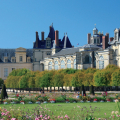The château is the only monument to bear continuous witness to the history of France from the to the century
Listed as a Unesco World Heritage site since 1981 and a Monument Historique since 1862, the Château de Fontainebleau is one of the jewels of France's heritage. Located some 60km from Paris, not far from the great forest of Fontainebleau, it is the only monument to bear continuous witness to the history of France from the 12th to the 19th century. Each sovereign has left his or her mark on the château, altering the legacy of previous rulers as little as possible. The château could almost be seen as a family home: over the centuries, each new occupant has been keen to make it his own and update it to suit modern tastes, while preserving the soul of the place. More than any other site, the Château de Fontainebleau epitomizes the French art of living, and the rooms on show bear witness to the different phases of history. Its architecture and interior decor blend medieval, Renaissance and classical styles. Fontainebleau, far from the hustle and bustle of the capital, was the perfect place for vacation and leisure. Etiquette here was a little less rigid than elsewhere; there was a certain freedom, so much so that sovereigns could indulge their fantasies and indulge in certain eccentricities. To stroll through the château is to travel through seven centuries of history. From one room to the next, you change era, discovering an interweaving of styles. The château has 1,500 rooms, some of which are now open to the public. These include the Grands Appartements, the Chinese Museum and the Napoleon I Museum. Located upstairs, the Grands Appartements include some of the château's most remarkable rooms, dedicated to the exercise of power and the life of the court. These include
The King's Apartment. From Henry III to Louis XVI, the royal apartments housed the king's bedroom, which is no longer revealed in its original guise, since Napoleon I had a throne room built there. Built in 1804, the throne is set on a platform in the alcove where the royal bed once stood. This is the last surviving Napoleonic throne room.
The entrance to the king's apartments features a staircase leading to the Cour Ovale, a fine illustration of the château's mix of styles. A staircase that has given rise to some funny situations over the centuries. It occupies the former bedroom of François I's mistress, the Duchesse d'Etampes. A close look at the stucco decorating the walls reveals representations of nude, erotic female figures dating back to the 16th century. Not a surprising discovery, given the libertine nature of Francis I, but one that shocked the wife of Louis XV, who in the mid-18th century demanded that female genitalia be covered by a veil of modesty.
Napoleon I's apartment. Refusing to occupy the same room as the sovereigns who preceded him, Napoleon I had Louis XVI's interior apartment refurbished in 1804. This explains the Louis XVI decor, enriched by Second Empire-style furniture.
The Queen's apartment. Like the king, the queen had her own personal staircase leading to the Cour Ovale. To reach the state bedroom, you have to pass through several antechambers and salons, including the remarkable and richly decorated Salon des Tapisseries. Most of the furniture dates from the Second Empire. Known as the Chambre de l'Impératrice, the former bedroom of the queens of France was occupied by all the sovereigns' wives, from Marie de Médicis to Marie-Antoinette (the room is nicknamed "the room of the six Marys", in reference to the six sovereigns bearing this name who occupied it), then by Napoleon I's wife, Empress Josephine. The furniture dates from the First Empire, and the walls are adorned with precious brushed silks made in Lyon in the late 18th century.
The Renaissance rooms. François I was responsible for transforming the medieval château into a true palace and extending it to the west with the creation of new, lavishly decorated rooms. Built between 1528 and 1530, the Galerie François Ier is a fine example of the Fontainebleau style. François I entrusted its decoration - a mixture of frescoes, panelling and eccentric stucco for the period - to Italian artists.
Among the many salons, antechambers and cabinets, you'll discover the salon de réception and its so-called "planet" ceiling, as well as the bedroom once occupied by Anne of Austria and its extraordinary profusion of decoration (ceilings, wood panelling set with Gobelins tapestries and painted panels...). In addition to these grand halls dedicated to public life, you'll also have the opportunity to admire, on guided tours only, more intimate spaces adapted to the daily life of the sovereigns: the Théâtre Impérial, the Petits Appartements, Mme de Maintenon's apartments, as well as Marie-Antoinette's Turkish boudoir. The château's exterior features three gardens: the Jardin de Diane, the Jardin Anglais and the Grand Parterre.
Did you know? This review was written by our professional authors.
The strengths of this establishment:
Members' reviews on CHÂTEAU DE FONTAINEBLEAU
The ratings and reviews below reflect the subjective opinions of members and not the opinion of The Little Witty.















Il n'en est rien, ce château est magnifique même par un hiver humide qui ne permet pas de profiter de l'extérieur.
Il est grand, très grand .... meuble avec beaucoup d'ornements et d'objets témoignant de l'histoire de France.
A visiter absolument.
On n'a pas pris l'audio guide qui était en supplément, mais même sans c'est super.
Attente longue à la caisse, d’où la note sur le service. Prix élevés en plein tarif, mais aucun regret
La visite n'est pas trop chère et propose de visiter de nombreuses salles.
Très interessant